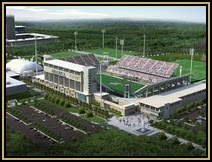
In 2000, UAlbany alumnus Bill Fuller Jr. wouldn't have considered writing a check to his alma mater's athletics department. He had no reason to.
"Not at all. I felt it was a large community college and it really didn't bring people back to it, didn't hold on to alumni," said Fuller, a 1984 graduate and president of R.C. Fuller Inc. in Locust Valley in Nassau County. "It didn't really offer anything."
That's coming from a man who said he's committed about $50,000 in donations to the athletics department over the past several years.
It's a story line that University at Albany athletics director Lee McElroy has seen a lot lately: Donors who once didn't want to help out are now happy to give, and many existing donors are compelled to give more to help boost the school's 19 athletic programs.
A string of nationally noticed athletic achievements--what Fuller called "tangible product"--has been a rising tide lifting the entire department. And the victories come at an opportune time: McElroy might need to raise as much as $10 million for a new stadium that's in the works.
The rekindled school spirit has translated into more donations and a larger budget. In the past five years, revenue from donations, ticket sales and corporate advertising combined have more than tripled to $2.15 million.
Athletics officials project that the budget will near $12 million for the 2009-10 school year, about $5 million more than where it stood when McElroy took over. He has said the new stadium could more than double the size of the current budget.
"They had a reason to say, 'Yes,' " McElroy said of new and existing donors. "The pride, the exposure--it's had a really, really profound impact on how they feel about the institution."
Many alumni openly gush about the Great Danes now, but McElroy didn't see such pride when he began his job in 2000. The year before, the school officially made the jump to Division I athletics, a demanding move to the highest level of competition in the National Collegiate Athletic Association.
"We were so under-resourced and under-funded as a Division II or Division III program, not to mention a Division I program," McElroy said. "Literally, I was going knocking on doors saying, 'Look, we need your help to keep the doors open so we can compete.'
"I had people say, 'I don't even know if I ever went to a game when I was in college there. Why should I be supporting it?' " he said.
McElroy patiently constructed the answer to that pointed question. The school joined a conference for the 2001-02 school year, helping the programs gain acclaim partly because its teams could win conference championships--which many teams did.
The building momentum exploded in the spring of 2006, when the men's basketball team won the conference championship and nearly upset No. 1 seeded Connecticut in the NCAA Tournament. The team followed up that year with another conference title and NCAA appearance this spring.
"The entire message changed," McElroy said. "It changed from trying to keep the doors open, to now, sustaining this level of excellence--which is an entirely different sell."
And McElroy is mainly focused on selling one big-ticket item: a new multi-use stadium, the centerpiece of a development plan he created soon after he came to Albany.
The school has submitted a $60 million proposal to the State University of New York system's board of trustees. It's just an initial offer that will likely change once the trustees and state officials start delving into the details.
Peter Bulger, an alumnus and donor, spoke enthusiastically about the new stadium but said many donors are taking a wait-and-see approach.
"I think the No. 1 resistance is the feeling that you're giving to the state of New York, as opposed to a specific university," said Bulger, chief operating officer for CL King and Associates in Albany.
"Right now, everyone wants to see the state of New York either step up or not step up. If they say they're going to basically build it ... people will be more apt to follow," he added. "It's very difficult for the private sector to lead on this."
This month, the school is expected to award a contract of at least $250,000 to recommend the best location for the stadium, said spokesman Brian DePasquale.
After that, engineers and architects will step in to design the stadium; school officials have said that settling on the stadium's general look and location will likely make it easier to sell the project.
Armed with just a conceptual drawing, McElroy is pitching the facility as a prudent investment that will help put the program on a par with its peers in the conference and the state, while attracting countless regional and statewide events.
He said he sees a stark improvement from when he went door to door in 2000.
"I've not had anyone say, 'No.' "
by Adam Sichko The Business Review
Friday, October 26, 2007
UAlbany's athletic successes revive school spirit and spur donors
Posted by
BRE
at
6:56 AM
![]()
Labels: Football Stadium, UAlbany sports, University at Albany
Subscribe to:
Post Comments (Atom)

.jpg)




.jpg)
+(2).jpg)
.jpg)
.jpg)

.jpg)
+(2).jpg)
+(2).jpg)
+(2).jpg)
_(2)+(2).jpg)
+(2).jpg)
+(2).jpg)
_(2)+(2).jpg)
+(2).jpg)


.jpg)
.jpg)
+(2).png)
+(2).jpg)
.jpg)
.jpg)
+(2).jpg)
+(2).jpg)
+(2).jpg)
.jpg)
+(2).jpg)
+(2).jpg)
+(2).jpg)
_(2)+(2).jpg)
+(2).jpg)
.jpg)
+(2).jpg)
+(2).jpg)
+(2).jpg)
.jpg)
.jpg)
+(2).png)
.jpg)
.jpg)
.jpg)
.jpg)
+(2).jpg)
+(2).jpg)

.jpg)

+(2).jpg)
.jpg)
.jpg)
.jpg)
.jpg)
.jpg)
.jpg)
.jpg)
.jpg)
.jpg)
.jpg)
.jpg)
.jpg)
.jpg)
.jpg)
.jpg)
.png)
.png)
.jpg)
.jpg)
.jpg)
.jpg)
.jpg)
.jpg)
+(2).jpg)
.jpg)
+(2).jpg)
.jpg)
+(2).jpg)
.jpg)
.jpg)
.jpg)
.jpg)
.jpg)
.jpg)
.jpg)
.jpg)
.jpg)
.jpg)
.jpg)
.jpg)
.jpg)
.jpg)
.jpg)
.jpg)
.jpg)
.jpg)
.jpg)
.jpg)
.jpg)
.jpg)
.jpg)
.jpg)
.jpg)
.jpg)
.jpg)
.jpg)
.jpg)
.jpg)
.jpg)
.jpg)
.jpg)
.jpg)




No comments:
Post a Comment